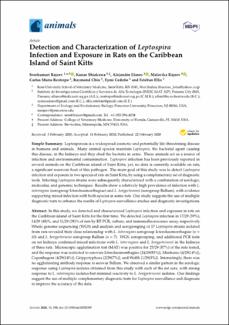Mostrar el registro sencillo del ítem
Detection and Characterization of Leptospira Infection and Exposure in Rats on the Caribbean Island of Saint Kitts
| dc.contributor.author | Rajeev, Sreekumari | |
| dc.contributor.author | Shiokawa, Kanae | |
| dc.contributor.author | Llanes, Alejandro | |
| dc.contributor.author | Rajeev, Malavika | |
| dc.contributor.author | Restrepo, Carlos Mario | |
| dc.contributor.author | Chin, Raymond | |
| dc.contributor.author | Cedeño, Eymi | |
| dc.contributor.author | Ellis, Esteban | |
| dc.date.accessioned | 2020-06-13T03:31:11Z | |
| dc.date.available | 2020-06-13T03:31:11Z | |
| dc.date.issued | 2020-02-22 | |
| dc.identifier.other | doi:10.3390/ani10020350 | |
| dc.identifier.uri | http://repositorio-indicasat.org.pa/handle/123456789/55 | |
| dc.description | In this study, we detected and characterized Leptospira infection and exposure in rats on the Caribbean island of Saint Kitts for the first time. We detected Leptospira infection in 17/29 (59%), 14/29 (48) %, and 11/29 (38) % of rats by RT-PCR, culture, and immunofluorescence assay, respectively. Whole genome sequencing (WGS) and analysis and serogrouping of 17 Leptospira strains isolated from rats revealed their close relationship with L. interrogans serogroup Icterohaemorrhagiae (n = 10) and L. borgpetersenii serogroup Ballum (n = 7). WGS, serogrouping, and additional PCR tests on rat kidneys confirmed mixed infections with L. interrogans and L. borgpetersenii in the kidneys of three rats. Microscopic agglutination test (MAT) was positive for 25/29 (87%) of the rats tested, and the response was restricted to serovars Icterohaemorrhagiae {24/29(83%)}, Mankarso {4/29(14%)}, Copenhageni {4/29(14%)}, Grippotyphosa {2/29(7%)}, and Wolffi {1/29(3%)}. Interestingly, there was no agglutinating antibody response to serovar Ballum. We observed a similar pattern in the serologic response using Leptospira isolates obtained from this study with each of the rat sera, with strong response to L. interrogans isolates but minimal reactivity to L. borgpetersenii isolates. Our findings suggest the use of multiple complementary diagnostic tests for Leptospira surveillance and diagnosis to improve the accuracy of the data | en_US |
| dc.description.abstract | In this study, we detected and characterized Leptospira infection and exposure in rats on the Caribbean island of Saint Kitts for the first time. We detected Leptospira infection in 17/29 (59%), 14/29 (48) %, and 11/29 (38) % of rats by RT-PCR, culture, and immunofluorescence assay, respectively. Whole genome sequencing (WGS) and analysis and serogrouping of 17 Leptospira strains isolated from rats revealed their close relationship with L. interrogans serogroup Icterohaemorrhagiae (n = 10) and L. borgpetersenii serogroup Ballum (n = 7). WGS, serogrouping, and additional PCR tests on rat kidneys confirmed mixed infections with L. interrogans and L. borgpetersenii in the kidneys of three rats. Microscopic agglutination test (MAT) was positive for 25/29 (87%) of the rats tested, and the response was restricted to serovars Icterohaemorrhagiae {24/29(83%)}, Mankarso {4/29(14%)}, Copenhageni {4/29(14%)}, Grippotyphosa {2/29(7%)}, and Wolffi {1/29(3%)}. Interestingly, there was no agglutinating antibody response to serovar Ballum. We observed a similar pattern in the serologic response using Leptospira isolates obtained from this study with each of the rat sera, with strong response to L. interrogans isolates but minimal reactivity to L. borgpetersenii isolates. Our findings suggest the use of multiple complementary diagnostic tests for Leptospira surveillance and diagnosis to improve the accuracy of the data | en_US |
| dc.format | application/pdf | |
| dc.language.iso | eng | en_US |
| dc.rights | Info:eu-repo/semantics/openAccess | |
| dc.rights | https://creativecommons.org/licenses/by/4.0/ | |
| dc.subject | Detection and Characterization | en_US |
| dc.subject | Leptospira Infection and Exposure | en_US |
| dc.subject | Caribbean Island of Saint Kitts | en_US |
| dc.title | Detection and Characterization of Leptospira Infection and Exposure in Rats on the Caribbean Island of Saint Kitts | en_US |
| dc.type | info:eu-repo/semantics/article | en_US |
| dc.type | Info:eu-repo/semantics/publishedversion |

